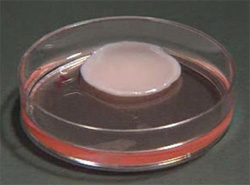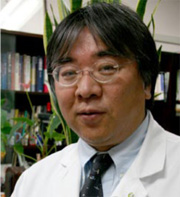Home > Highlighting JAPAN > Highlighting Japan JULY 2012 > Cardiac Regenerative Therapy Using Cell Sheets
Highlighting JAPAN
[SERIES] SCIENCE & TECHNOLOGY
Cardiac Regenerative Therapy Using Cell Sheets
In the field of heart disease treatment, the regeneration of the heart muscle using cell sheets, a groundbreaking therapy developed in Japan, has recently been attracting a great deal of attention. Patients suffering from severe heart disease once had no choice but to rely on heart transplants or an artificial heart, but now they can return to good health using this new treatment technique. Takashi Sasaki reports.

A myoblast cell sheet (approx 5 cm in diameter) ready to be affixed to a patient's heart muscle
Credit: COURTESY OF PROFESSOR YOSHIKI SAWA
Professor Sawa reports that when he learned about the research results of cell sheets twelve years ago at the Japanese Society for Artificial Organs, he thought he could apply them to his specialty, the field of heart disease treatment. He immediately proposed to Professor Okano that they establish a joint research project, and Professor Okano readily accepted his proposal. Professor Sawa noted that, at that time, the potential of cell sheets had not yet been fully evaluated, and he believed that his team would be the first to start clinical research.
As Professor Sawa continued to experiment, starting with mice and moving on to pigs and other animals, he found the results were better than he had anticipated. In 2007, Professor Sawa started clinical research on a human patient with heart disease.
How the New Therapy Works
The research group developed the following therapy. First, skeletal myoblasts in their early development stage are harvested from the patient's thigh. They are then extracorporeally cultured to form a sheet of approximately five centimeters in diameter. Four sheets are then stacked and affixed to about six parts of the patient's heart muscle. After this operation, new vascular networks are developed in the patient's heart and the weakened cardiac muscle cells start to become revitalized by protein and other substances released from the skeletal myoblast sheets.
The use of cultured myoblasts has been proposed in the past, but all of the proposals adopted a method in which cultured myoblasts were injected directly into the heart muscles. This approach, however, has not always produced the results expected, and has sometimes triggered cardiac arrhythmia and other problems. Professor Sawa has performed fourteen cell-sheet transplant surgeries over the past five years. Although all of these patients had serious heart problems or had artificial hearts implanted while they waited for their heart transplant, all reportedly regained their health and were discharged from hospital. In particular, two thirds managed to improve their condition so dramatically that they were able to have their artificial heart removed.

Professor Yoshiki Sawa in the Department of Cardiovascular Surgery at Osaka University Hospital
Credit: TAKASHI SASAKI
In the case of a heart transplant, in fact, because patients use the organs of other people, they need to take immunosuppressive drugs throughout their lives, at a cost of up to several million yen a year. If patients receive an artificial heart, the systems are very expensive and require regular maintenance. As a result, it is difficult for the patients to leave hospital and restart a normal life. For this reason, an artificial heart is really only a system that supports the patients while they are waiting for a heart transplant. On the other hand, surgery to affix cell sheets is low risk in itself, and the recovery in heart functions is noticeably good.
Professor Sawa believes that his patients appear not only to recover physically, but also become mentally energetic, happy, and positive, perhaps because they have been able to overcome a serious malady using the tissues of their own bodies. He takes great pleasure in witnessing the positive changes in patients' attitudes.
Toward Commercial Application
Following these excellent outcomes from the clinical research, Terumo Corporation, a manufacturer of medical products, announced in February 2012 that it would start clinical trials of cardiac regenerative therapy using myoblast cell sheets. It expects to work with Osaka University to develop commercial products. In the meantime, to facilitate the development of cell sheets that regularly contract in tandem with the beating of the heart, Professor Sawa and his team have started research into developing cell sheets that use induced pluripotent stem cells (iPS cells) instead of femoral muscle myoblasts. When this type of cell sheet is developed, patients with extremely serious heart disease, in which the functions of the heart have fallen to a level beyond the ability of current cell sheets to help, will see some hope of a cure in the future.
© 2009 Cabinet Office, Government of Japan






